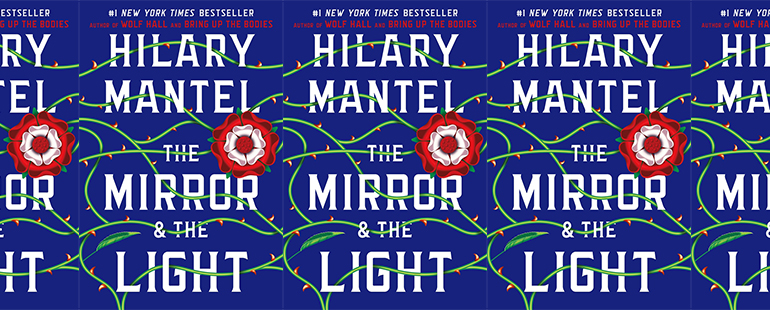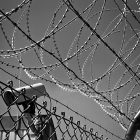Hilary Mantel’s Tudor Mirror

We say it to others as we say it to ourselves. We say it when it seems impossible: “So now get up.” It is an expression of will that reflects back upon its speaker. In it there is anguish, determination, hope, wish-fulfillment, glee, self-satisfaction, relief. Sometimes, in speaking, we try to make our words become truth, while at other times, our speech verifies a truth. The phrase underscores a prerequisite rather than a choice. One must get up to go on existing. Life and narrative are mirrored in this necessity. It is the injunction by which we are governed and which governs our fictions, even fictions about the dead, as Hilary Mantel demonstrates in her nearly two-thousand-page trilogy that begins with these words and chronicles the extraordinary rise and fall of Thomas Cromwell (c. 1485-1540), Henry VIII’s infamous factotum, councilor, Master Secretary, Master of the Rolls, Chancellor of Cambridge University, Lord Keeper of the Privy Seal, Chancellor of Augmentations, Knight of the Garter, Baron of Wimbledon, Captain of the Isle of Wright, Constable of Leeds Castle, Earl of Essex, and Vicegerent in Spirituals—or, as Jane Seymour, Henry VIII’s unfortunate third wife—who lies down to give birth to Edward VI and never gets back up—puts it, “he who does everything in England. . .the government and the church as well.”
Written over a period of more than ten years, the trilogy—Wolf Hall (published in 2009 and winner of that year’s Booker Prize), Bring up the Bodies (2012, Booker Prize again), and The Mirror and the Light (out in 2020 shortlisted for the Women’s Prize for Fiction)—is an experiment in the genre of historical fiction as much as it is an exercise in historical revisionism. It poses a version of the Sphinx’s old riddle: “What goes on four feet in the morning, two feet at noon, and three feet in the evening?” Henry VIII, one might answer, whom we meet as a youthful, “large, broad, benign” monarch in Wolf Hall but who, by the end of the Mirror and the Light, seems elderly and suffers from a perpetually-oozing leg wound, which causes him to limp and disturbs his judgement, making him “ill, disabled, and dangerous.” Or perhaps Cromwell, whom we meet in Wolf Hall as a child crawling on all fours, “felled, dazed, silent; knocked full length on the cobbles of the yard” by his drunk father, and who in the Mirror and the Light “remembers himself at eighteen years of age, a shattered creature crawling from the battlefield, creeping through Italy till he came to rest—or a halt, anyway—at the gate of the Frescobaldi banking house.” By the last book, he “is planning his own Ascension Day,” and yet, he, too, “limps along,” troubled by an old wound that hints at the figurative lateness of the hour. There are other examples. What goes up must come down, if only because the scope of human action is delimited by time, and we grow up only to grow sick and old.
Mantel, however, is also interested in other patterns that we construct to answer the riddle. As she demonstrates, the question to which the answer is “man” can be reframed in broader terms: what is the shape of a human life, and how do we narrate it? Are not all our narrations, like all our selves, projected backwards into the past as memory and forwards into the future as guesswork, always at least partially fictitious? Do not all histories, consciously or unconsciously, reflect back the historian, shaped as they are by her education, prejudices, and interests? Is history itself not just one long ghost story in which we raise the dead, a series of resurrections that we perform in the mind, practicing getting up, like Lazarus? “Lazarus, of course, died twice,” Cromwell points out in The Mirror and the Light. “The second time it was for good and all. . .The crippled man walks, but only twice around the churchyard before he collapses in a flailing of limbs. The blind man sees, but the faces he knew in his young days are altered; and when he asks for a mirror, he doesn’t recognize himself at all.” Time, Mantel suggests, is the mirror in which we see ourselves, and the uncertain reflections we cast change according to the source and quality of the light.
Here is an example of such a blind man. Towards the end of Wolf Hall, in the year 1534, Cromwell questions Thomas More, the recalcitrant Lord Chancellor of England, in the Tower of London. More refuses to sign Henry VIII’s Oath of Supremacy or to agree that the king, rather than the Pope, is the rightful head of the Church. More is defiant: “You say Parliament is behind you, and I say all the angels and saints are behind me, and all the company of the Christian dead, for as many generations as there have been since the church of Christ was founded, one body, undivided.” Cromwell is exasperated: “You call history to your aid, but what is history to you? It is a mirror that flatters Thomas More. But I have another mirror, I hold it up and it shows a vain and dangerous man, and when I turn it about it shows a killer, for you will drag down with you God knows how many, who will only have the suffering, and not your martyr’s gratification.” Cromwell is right, of course: there is always more than one mirror we can hold up to our actions, more than one way of looking at the same events. In Mantel’s carefully researched trilogy, More, in his quest to root out heresy, becomes not only responsible for the torture, burning, beating, and dismembering of schismatic Londoners with Protestant leanings (Mantel names them and resurrects them and gives them lives and stories), but also accountable for the actions of all those whom he won to his cause. “It all goes back to More,” Cromwell muses in The Mirror and the Light. “Nothing ended with his death. . .it only began. When he was alive and Lord Chancellor, [Bishop John] Stokesley used to aid him, raiding houses, hauling men and women to prison.” Despite the break with Rome, “that blood-truffler Stokesley is still at work.”
It is not only Stokesley—who will still be overseeing burnings in 1540—who makes Mantel’s Cromwell furious back in 1534. He also holds More personally responsible for the fate of William Tyndale, the eloquent translator of the New Testament into English, who was burned at the stake in 1537, two years after More died, but whose capture More had “planned. . .from prison.” More had objected, among other things, to Tyndale’s translation of 1 Corinthians 13:13: “Now abideth fayth hope and love even these thre: but the chefe of these is love.” “Thomas More thinks [‘love’] is a wicked mistranslation,” Cromwell sighs. “He would chain you up for a mistranslation. He would, for a difference in your Greek, kill you.” Unfortunately, More cannot see himself in the mirror Cromwell holds up to him. Years later, however, neither will Cromwell be able to see himself in More’s, when he will prove just as ferociously dedicated to precise language. In the last installment of the trilogy, he questions the suspected papist Sir Geoffrey Pole, who must be persuaded to give evidence against his family, whose ancestry threatens the Tudor succession. “All you allege is words, words, words,” Geoffrey shouts. But, as Cromwell has learned in the intervening years, words are everything, and all guilty convictions rest on them.
Turn the mirror one way, and the past rises up in the form of a condemned, recalcitrant More and a circumspect, worldly Cromwell, who deplores violence. Turn it another way, and the circumspect reformer is himself planning executions. Turn it yet another way and, seven years later, in The Mirror and the Light, the two men will appear mirrored—doubles of one another. The condemned gospeller, Thomas Cromwell, will be arrested on treason charges, on the basis of the “first of those pernicious articles they passed through Parliament,” an article of law that asked Henry’s subjects to declare that the Eucharist is the literal body of Christ. He will sit in More’s place in Bell Tower. “Perhaps some people will say I have died for the gospel,” Cromwell will think, “as More died for the Pope.” As he will walk around the same prison’s “stony, vaulted, and spacious chamber,” where the walls “are twelve feet thick, and light falls from widows set high above the head,” the mirror will go on playing its tricks of light: “there is a figure sitting at the table. Silently he asks, ‘Is it you?’ Thomas More rises from his place, crosses the room and melts into the wall.” Cromwell has finally recognized himself reflected in his long dead enemy, but it is too late; he, too, is about to die. Mantel is exploring a great irony. More, whom Cromwell describes in Wolf Hall as someone for whom “everything you know, and everything you’ve learned, confirm you in what you believed before,” turns out to be a reflection of Cromwell, self-described as someone for whom “what I grew up with, and what I thought I believed, is chipped away a little and a little.” In the end, being obstinate in your beliefs and being too susceptible to others’ turns out to mean the same thing.
As everyone in Cromwell’s world would have known, the mirror is a good metaphor for such surprises the future may reveal and for explaining the patterns of both time and our lives in time. By the early modern period, the literary genre of the specula principum—or the “mirrors of princes”—had become extremely popular. Such “mirrors,” or conduct manuals teaching vices and virtues, functioned both as princely self-help books and as examples of “how the world goes,” to borrow a phrase from Shakespeare’s Coriolanus. Well-known examples, like Desiderius Erasmus’s Education of a Christian Prince (1516) and Baldassare Castiglione’s Book of the Courtier (1528) taught, as the 1559 Mirror for Magistrates puts it, both “with howe grievous plagues vices are punished” and “howe frayle and unstable worldly prosperitie is founde, even of those, whom fortune seemeth most highly to favour.” If they encouraged good conduct, they also showed, to quote Thomas More himself, in The Book of Fortune (published posthumously in 1540), how “Fortune. . .laughs, and in her throne / Amid her treasure and wavering riches, / Proudly she hovers as lady and empress.” In these texts that carefully consider the mutability of all worldly things, not just the human body but social life, political life, and the world itself become pious reminders of the cycle of dominion and decline. Careers, dynasties, empires, all pattern themselves on the individual, “frail and unstable.”
As the title of the recently published Mirror and the Light suggests, Mantel’s trilogy can be seen as a belated experiment in the speculum genre. She undertakes it in part because she seems to want to see history through Cromwell’s eyes, as he would have seen it. “In the old stories,” Cromwell thinks, “a great mirror is set before the palace of the king. It is as wide as the sky, and three thousand warriors guard it. . .Even by night they guard it, when it reflects nothing but a kingdom blanketed in darkness, and perhaps the faint etched line of a star.” Cromwell takes himself to be Henry’s much-improved mirror, and, in the last volume of the trilogy, he is writing a speculum for the next generation. “He is composing in his mind ‘the book called Henry.’” As his work’s title suggests, such a book’s purpose is not to educate the king, but to instruct those who come after him how to best deal with the king’s erratic behavior and prosper. The stakes are so high as to be almost unbearable. In his mind the king transforms into a mythic giant, “and what then? Either he kills you, or you are one of those left, picking up remnants.” Cromwell does not want to be killed; so he keeps his book-in-progress to himself, reads Machiavelli’s Prince, an elegant subversion of the genre, smuggled in via the Low Countries, and daintily, if disingenuously, compliments Henry by telling him that he is the ideal monarch, “the mirror and light of all other kings and princes in Christendom,” even as he continues to pick up the remnants after each of Henry’s “killing fits.” In his own behavior, he tries to set a temperate course and to be moderate in both beliefs and practices. “Try and keep cheerful,” he suggests unironically in his secret book. “He has read a library of those volumes called Mirrors for Princes, which state the wise councilor must always prepare for his fall,” but only with his successors in mind.
Structurally, however, the trilogy is a mirror reflecting back a series of falls that culminate in Cromwell’s own disgrace. Wolf Hall begins with a fall—Cromwell remembering the worst beating of his life. As it proceeds, Cromwell’s first master, the cardinal Thomas Wolsey, falls in turn, exiled and hounded by Henry. The bereaved Cromwell, however, survives, and he ingratiates himself with the king. He rises. At his command, he brings about the falls of others: that of Katherine of Aragon, Henry’s first wife; that of Mary I, their daughter; of Thomas More; and of John Fisher, the Bishop of Rochester. He shapes the ascendancy of Anne Boleyn and helps make her queen. In Bring Up the Bodies, once Henry has determined he will have Jane Seymour, Cromwell then helps to orchestrate the fall of the Boleyn family. He oversees the treason trial that will eventually lead to Anne Boleyn’s execution and those of her supposed paramours. In The Mirror and the Light, fate and fortune bring others down: Margaret (Meg) Douglas, Princess of Scotland and Henry VIII’s niece; Jane Seymour; the Exeters and Courtenays, ancient Plantagenet families with claims to the throne. Cromwell does his part, as he must, even as he tries to keep those he cares for from tumbling with them. His work takes on gargantuan proportions. In the service of the king, he brings down one Church and puts up another, he dissolves the monasteries, he raises houses and fortifications. He smiles, thinking he has seized Fortune by the forelock: “It used to be that, if you and your kind stuck doggedly to the wheel of fortune, you would rise as far as you had fallen. But then comes a fellow like me, and knocks you clean off the wheel. Be advised, I can do it.” Cromwell’s mistake, of course, is to be incapable of seeing himself in the mirror. He seems to think that, if he can bring back the king from near death, as he does in Bring Up the Bodies (in 1536 Henry has a jousting accident from which he will never fully recover, and Cromwell pounds his chest “like a merchant closing a deal” until the king sits up), he can also settle old scores, augment his own state, and play God—or King. “Sometimes, sitting beside the king—it is late, they are tired, he has been working since first light—he allows his body to confuse with that of Henry.” It is a fatal mistake. Read as speculum literature, the trilogy fittingly ends in tragedy.
The speculum, however, is not the trilogy’s only mirror. As Mantel knows, in a work of fiction, the mirror of the past is always also the mirror of the literary past. “Why does the future feel so much like the past,” she asks herself through Cromwell:
the uncanny clammy touch of it, the rustle of bridal sheet or shroud, the crackle of fire in a shuttered room? Like breath misting glass, like the nightingale’s trace on the air, like a wreath of incense, like vapour, like water, like scampering feet and laughter in the dark. . .In stories there are folk who, observed at dawn or dusk in some open, watery space, are seen to flit and twist in the air like spirits, or fledge leather wings through their flesh. Yet he is no such wizard. He is not a snake who can slip his skin. He is what the mirror makes, when it assembles him each day: Jolly Tom from Putney. Unless you have a better idea?
Mantel does. After all, we are in a novel. If Cromwell is the slithery Melusine, whose story is woven into the fabric of Wolf Hall, he is also Jay Gatsby, blind to the fickleness of the recipient of his all-consuming attention (though Henry VIII makes a poor Daisy). He is Kurtz at the ends of the earth, who, in the last moments of his life, sees a truth dancing in the candle flame that he cannot name (though Cromwell is less horrified). He is the ever-practical Leopold Bloom surveying his kitchen and keeping a cat (though Marlinspike is a much less compliant feline, and Cromwell—“Crumb”— has more refined tastes). Perhaps, most terrifyingly, he is also one of the bureaucrats in K.’s castle, a man who counts his “effects before consequences.”
We understand him, we come to appreciate him, we follow his mind darting about his skull, we see him turn words into reality. When Meg Douglas, the King’s niece, is imprisoned for her clandestine marriage to a member of the Howard family and asks him, “My marriage is not a crime, is it?” Cromwell responds: “Not yet. . . But I am sure it will be. We can get a bill through before Parliament rises.” And he does. Her lover is charged with treason, and it is declared that they were never married. Mantel would like us to think that this is the mind of a visionary, of a great public statesman, of a man who understands the power of words. And it is. But in our early-twenty-first-century mirror, this is also the mind of a character who drafts proceedings, irons out protocols, grasps the law by the lapels and shakes it until it gives him what he wants. When he tries to explain to the Constable of the Tower of London that he can make laws that apply retroactively to the past and so punish Meg Douglas’ lover, because “a prince cannot be impeded by temporal distinctions: past, present, future,” we do not see him as ingenious; rather we are reminded of O’Brien in George Orwell’s 1984, who teaches Winston that “the past was alterable.” If Cromwell is in some ways a man made up entirely of words, he is also a product of the literature of our time. In his world, we see our own.
But we don’t think in terms of Fortune and, for the most part, our modern novels are not stories about unbounded hubris and its dire consequences. We do not hold a mirror up to nature so much as use it to reflect our own thoughts back to ourselves. There is, then, a third way in which the novel can be read. If Mantel’s past seems much like the future, it is because, when we try to glimpse either, often all we see is ourselves. As W. B. Yeats puts it, the “soul” is “its own betrayer, its own deliverer, the one / activity, the mirror turn lamp.” Or, as M.H. Abrams wrote in The Mirror and the Lamp: Romantic Theory and the Critical Tradition, there are “two common and antithetic metaphors of mind, one comparing the mind to a reflector of external objects, the other to a radiant projector which makes a contribution to the objects it perceives. The first of these was characteristic of much of the thinking from Plato to the eighteenth century; the second typifies the prevailing romantic conception of the poetic mind.” In the second case, “often the reflector is reversed and images a state of mind rather than external nature.” In other words, as the metaphorical source of illumination moves inwards, the mirror illuminates thought, feeling, and mood rather than objective reality. “What survives from this year past?” Cromwell asks himself in 1536. “Rafe’s garden at midsummer, the lusty cries of the child Thomas issuing from an open window; Helen’s tender face. The ambassador in his tower at Canonbury, fading into twilight. Night falling on the rock of Windsor Castle, as on a mountain slope.” This is the domain of the novel. As the long, plot-driven sections in which we see Cromwell advance his career, sections that sometimes run the danger of reading too much like a historical chronicle, give way to moments of intense, almost sublime lyricism, Mantel probes Cromwell’s consciousness and her own, turning the source of illumination inward, from pre-modern light into modern lamp. The passages function like Wordsworthian “spots of time,” memories “that give / Profoundest knowledge to what point, and how, / The mind is lord and master—outward sense / The obedient servant of her will.”
For Cromwell, as for Wordsworth, these moments are not past; they are ever living, ever-present in the mind. “In the blink of an eye, in the space of an Ave, he is somewhere else: he is at Launde Abbey, on the cardinal’s business: on a day of buzzing heat, a young fellow laughing with the monks in a garden.” As he gets older, they increasingly become moments when the dead return to ask their due: “There is a place, a sequestered place in the imagination, where the eel boy is always waiting to be whipped, where George Boleyn is always in his prison room, always rising in welcome: Master Cromwell, I knew you would come. As George had stood, his hands held out, an image had stirred inside him, and he was elsewhere: in some other enclosed space, the light failing, as if a shutter had half-closed.” Such moments suggest that the past is always present, or rather, that our present is always informed by what has gone on before. As we move through time, the past moves within us. Cromwell’s memories return again and again, slightly altered each time, to haunt each installment of the trilogy. It does happen too often. In part, Mantel is unsuccessfully trying to solve the problem of writing non-repetitive but consistent sequels. But she is also, like Wordsworth, interested in how our memories change over time to become our mirror.
In the book’s larger mirror, history is revised and Cromwell becomes, for better or worse, both the sinister factotum and the product of Mantel’s imagination, both historical figure and literary character. Different ways of patterning time compete in a subgenre that must be faithful to its sources as well as to its readership. Mantel’s solution is flawed, but it is astonishingly innovative, masterful in scope, and ambitious enough to prove that there need be no division between the literary novel and historical novel, or between the past as narrative and the past as fiction. She sees, as few historical novelists have before, “how [the dead] are visible, and how they shine. They are distilled into a spark, into an instant. There is air between their ribs, their flesh is honey-combed with light, and the marrow of their bones is molten with God’s grace.” The spark that illuminates them is entirely her own.
This piece was originally published on April 30, 2020.



